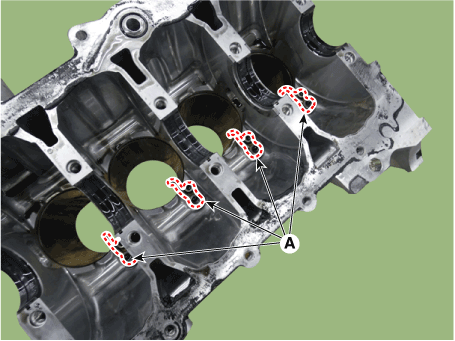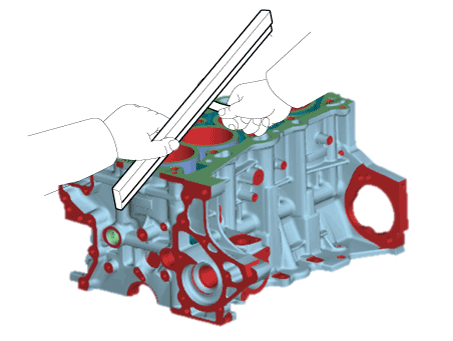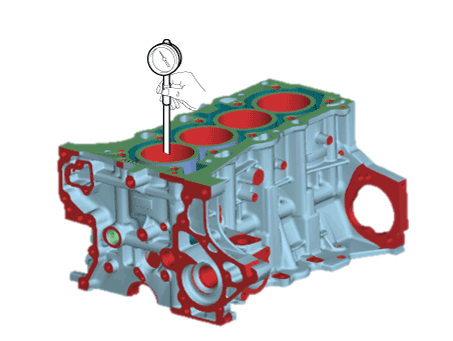Hyundai Elantra: Cylinder Block / Cylinder Block
Repair procedures
| •
| Use fender covers to avoid damaging painted surfaces. |
| •
| To avoid damage, unplug the wiring connectors carefully while holding the connector portion. |
|
| •
| Mark all wiring connector and hoses to avoid misconnection. |
| •
| To release the fuel system pressure before removing the engine assembly, start the engine without fuel pump relay. Then, switch "OFF" the ignition when engine stops. |
| •
| Turn the crankshaft pulley so that the No. 1 piston is at top dead center. |
|
| 1. | Remove the crankshaft. (Refer to Cylinder Block - "Crankshaft") |
| 2. | Remove the water jacket insert. (Refer to Cylinder Block - "Water Jacket Insert") |
| 3. | Remove the knock sensor. (Refer to Engine Control / Fuel System - "Knock Sensor (KS)") |
| 4. | Remove the crankshaft position sensor (CKPS). (Refer to Engine Control / Fuel System - "Crankshaft Position Sensor (CKPS)") |
| 5. | Remove the piston cooling oil jets (A). 
|
| 1. | Using a gasket scraper, remove all the gasket material from the top surface of the cylinder block. |
| 2. | Using a soft brush and solvent, thoroughly clean the cylinder block. |
| 3. | Inspect the top surface of cylinder block for flatness. Using a precision straight edge and feeler gauge, measure the surface contacting the cylinder head gasket for warpage. Flatness of cylinder block gasket surface : Less than 0.05 mm (0.0020 in.) for total area Less than 0.02 mm (0.0008 in.) for a section of 100 mm x 100 mm (3.9370 in x 3.9370 in.) |

|
| 4. | Visually check for scratches on the inside surface of the cylinder bore and replace the cylinder block if any noticeable scratch is detected. If deep scratchs are present, replace the cylinder block. |
| 5. | Using the cylinder bore gauge, measure the cylinder bore’s inner diameter to the axial and axial perpendicular directions. Cylinder bore diameter : 75.60 - 75.63 mm (2.9764 - 2.9776 in.) |

|
| •
| Thoroughly clean all parts to assembled. |
| •
| Before installing the parts, apply fresh engine oil to all sliding and rotating surfaces. |
| •
| Always use new gaskets, O-ring and oil seals. |
|
| 1. | Install the piston cooling oil jets (A). Tightening torque : 8.8 - 12.7 N.m (0.9 - 1.3 kgf.m, 6.5 - 9.4 lb-ft) |

|
| 2. | Install the crankshaft. (Refer to Cylinder Block - "Crankshaft") |
| 3. | Check the crankshaft end play. (Refer to Cylinder Block - "Crankshaft") |
| 4. | Disconnect the lower crankcase and check crankshaft bearing oil clearance. (Refer to Cylinder Block - "Crankshaft") |
| 5. | Install the piston and connecting rod assembly. (Refer to Cylinder Block - "Piston and Connecting Rod") |
| 6. | Check the connecting rod bearing cap oil clearance. (Refer to Cylinder Block - "Piston and Connecting Rod") |
| 7. | Check the connecting rod end play. (Refer to Cylinder Block - "Piston and Connecting Rod") |
| 8. | Assemble the other parts in the reverse order of disassembly. | •
| In case the cylinder block is replaced with a new one, select the proper crankshaft main bearing and the piston according to the crankshaft journal bore mark and the cylinder bore mark on the cylinder block. |
| •
| Crankshaft main bearing selection (Refer to Cylinder Block - "Crankshaft") |
| •
| Piston selection (Refer to Cylinder Block - "Piston and Connecting Rod") |
|
|
Repair procedures
Disassembly
•
Use fender covers to avoid damaging painted surfaces.•
To avoid damage, unplug the wiring connectors carefully while holding the connector portion...
Other information:
If there is a problem with the brake
pedal while driving, emergency braking
is possible by pulling up and holding
the EPB switch. Braking is possible only
while you are holding the EPB switch.
However, braking distance will be longer
than normal.
WARNING
Do not operate the parking brake while
the vehicle is moving except in an
emergency situation. It could damage
the brake system and lead..
Description and operation
DescriptionThe starting system includes the battery, starter, solenoid switch, ignition switch, inhibitor switch, ignition lock switch, connection wires and the battery cable.When the ignition key is turned to the start position, current flows and energizes the starter motor's solenoid coil.The solenoid plunger and clutch shift lever are activated, and the clutch pinio..
 Crankshaft
Crankshaft





